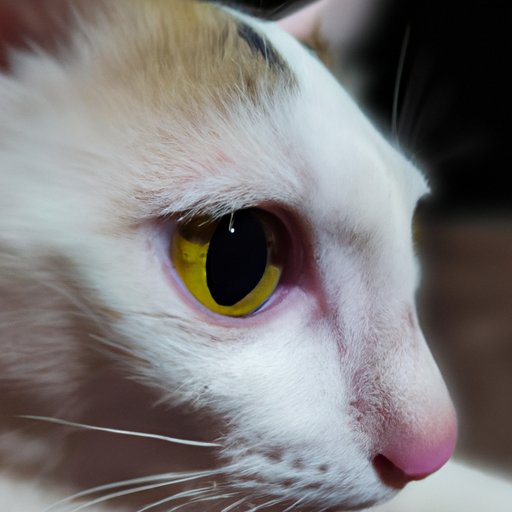
Introduction
Pink eye, or conjunctivitis, is a common eye infection that causes redness, swelling, and discharge. It can be caused by bacteria, viruses, or irritants. Pink eye is highly contagious and can spread easily from person to person. But what about cats? Can you get pink eye from a cat? In this article, we will explore the truth about cat pink eye, its transmission, prevention, and treatment.
The Truth About Pink Eye: Can Your Cat Be the Culprit?
Let’s start with the basics. Pink eye can be transmitted through contact with an infected person’s eye discharge, nasal discharge, or saliva.
In theory, pink eye can be transmitted from a cat’s eye discharge or dander. However, the likelihood of contracting pink eye from a cat is very low. According to the American Academy of Ophthalmology, it’s rare for humans to get pink eye from animals.
Additionally, not all cases of pink eye in cats are caused by infectious agents. It can also be caused by allergies, trauma, or other underlying health conditions. Therefore, it’s crucial to properly examine and diagnose the cause of your cat’s pink eye before assuming it’s contagious.
Cats and Pink Eye: What You Need to Know
As a cat owner, it’s important to know how to prevent and identify pink eye in your feline friend. Proper grooming habits and hygiene practices are critical to keeping your cat healthy.
To prevent pink eye in cats, keep their living environment clean and free of potential irritants, such as dust and smoke. Regular grooming can help remove irritants and prevent the buildup of discharge around the eyes. Be sure to also monitor your cat’s behavior for any signs of illness or discomfort.
If your cat does develop pink eye, take the proper precautions to avoid spreading it to other pets or humans. Isolate the infected cat and clean any areas it comes into contact with. Wash your hands before and after administering medication or caring for your cat.

Why Your Cat May Be More Susceptible to Pink Eye Than You Think
Cats can be particularly susceptible to pink eye due to their anatomy and living conditions. For example, cats with flat faces (such as Persians) are more prone to eye infections due to their close-set eyes and facial wrinkles.
Cats that live in overcrowded or unsanitary conditions are also at a higher risk of contracting infectious diseases, including pink eye. This is one reason why spaying and neutering your cat is important in controlling overpopulation and reducing the spread of diseases.
The Dangers of Feline Pink Eye for Humans
While the risk of contracting pink eye from a cat is low, it’s important to take proper precautions to avoid potential health risks. Humans who interact with infected cats may experience symptoms such as redness, swelling, and discharge in their own eyes or nose. In rare cases, more severe infections can occur.
To avoid transmission, wash your hands thoroughly with soap and water after handling an infected cat or their belongings. Avoid touching your face or eyes before washing your hands.
The Mystery of Cat Pink Eye: Causes and Symptoms
To properly care for your cat and prevent the spread of pink eye, it’s important to know the causes and symptoms to watch out for. Common causes of feline pink eye include bacterial or viral infections, allergies, and trauma.
The symptoms of pink eye in cats include redness, swelling, discharge, and squinting. Your cat may also be lethargic or show other signs of discomfort. If you suspect your cat has pink eye, consult your veterinarian to properly diagnose and treat the underlying cause.
Cat Pink Eye 101: Treatment and Prevention
Treatment for pink eye in cats will depend on the underlying cause. Your veterinarian may prescribe antibiotics, anti-inflammatory medication, or recommend natural remedies, such as warm compresses or eye drops. It’s important to follow the recommended treatment plan and keep your cat comfortable during their recovery.
To prevent future outbreaks of pink eye in your cat, practice good hygiene habits and maintain a clean living environment. This includes regular grooming, washing bedding and toys, and keeping litter boxes clean.
The Link Between Cat Pink Eye and Other Health Issues
In some cases, pink eye in cats may be a symptom of a larger health issue, such as an upper respiratory infection or an autoimmune disorder. It’s important to monitor your cat’s overall health and seek veterinary care if you notice any concerning symptoms.
For cats with compromised immune systems, such as senior cats or those with underlying medical conditions, pink eye can be particularly dangerous. In these cases, speak with your veterinarian about special precautions to take to keep your cat healthy.
Conclusion
While it’s rare for humans to get pink eye from cats, it’s important for cat owners to understand the causes, symptoms, and prevention methods associated with pink eye in cats. Proper hygiene practices, regular grooming, and veterinary care can all help prevent the spread of infectious diseases and keep your cat healthy.
If you have concerns about your cat’s eye health or behavior, consult with your veterinarian for proper diagnosis and treatment.





